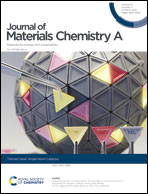Enhancing the inherent catalytic activity and stability of TiO2 supported Pt single-atoms at CeOx–TiO2 interfaces†
Abstract
Single-atoms (SAs) with atomically coordinated reaction centers are considered the next generation of catalysts that can exhibit exceptional catalytic efficiency. However, the general concern about thermodynamic vulnerabilities of SAs questions their practical value. Moreover, whether the inherent catalytic nature of SAs is superior compared with that of larger nanoparticles is still under debate. Here, we address two controversies by a comparative study using two catalysts: Pt/TiO2 and Pt/CeOx–TiO2. Based on a hierarchical study of density functional theory, time-resolved catalysis performance test, in situ infrared spectroscopy, and operando X-ray absorption spectroscopy, we could unveil the catalytic nature of Pt-SAs and their stability. By utilizing the heterogeneous interface formed between TiO2 supporting particles and CeOx clusters formed on the surface of TiO2, we preferentially synthesized Pt-SAs pinned at the CeOx–TiO2 interfaces on CeOx–TiO2 hybrid-oxide supports. The strong electronic coupling between the Pt-SAs and the Ce ions at the CeOx–TiO2 interfaces enhanced the catalytic activity toward CO oxidation of Pt-SAs and improved the long-term stability under CO oxidation conditions. The CO oxidation activity of Pt-SAs stabilized at CeOx–TiO2 was improved by 13.5 times at 200 °C compared with the Pt-SAs on TiO2. The results present how to easily improve the activity and stability of Pt-SAs using a simple interface control method. Moreover, we demonstrate that the catalytic activity and the stability of Pt-SAs can be monitored through the chemical state of the interfaces. Our study provides comprehensive understanding about the catalytic nature as well as a novel strategy toward applications of Pt-SAs, enabling sustainable use of Pt in heterogeneous catalysts.

- This article is part of the themed collection: Single-Atom Catalysis


 Please wait while we load your content...
Please wait while we load your content...